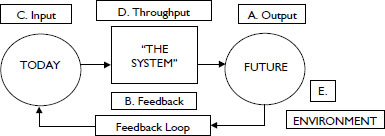II. The ABCs of
Strategic Management
The accompanying model and chart shows that Strategic Thinking is composed of four distinct phases (A, B, C, D) and a fifth element, E (the Environment). We call these the ABCs of Strategic Management. The reason for this is that any system (and especially an organization) can be described by four main phases (see following figure). This is because systems are made up of a set of components that work together for the overall objective of the whole (output).
![]() Thus
Thus
A system is defined as a series of inputs (Phase C) to a throughput or actions (Phase D) to achieve your outputs (Phase A) within the environment (E), along with a feedback loop (Phase B) to measure success.
Our A-B-C-D-E Phases start with the Future because we want to be proactive in creating our Ideal Future. This way of thinking not only can be used in Strategic and Business Planning (as we shall see in the rest of this Guide), but it is actually a different way of thinking in our lives. It can fundamentally change your life to begin thinking backwards from your Ideal Future (Phase A) on a regular basis. Once you do, then you will manage your life in a more proactive manner the same way the best organizations do.
(Five Key Elements)

A NEW ORIENTATION TO LIFE
(A–E: Five Key Elements)
“From Complexity to Simplicity”
Systems: Systems are made up of a set of components that work together for the overall objective of the whole (output).

Five Questions in Sequence
|
|
Where do we want to be? (i.e., our ends, outcomes, purposes, goals, holistic vision) |
|
|
How will we know when we get there? (i.e., the customers' needs and wants connected into a quantifiable feedback system) |
|
|
Where are we now? (i.e., today's issues and problems) |
|
|
How do we get there? (i.e., close the gap from C |
|
|
What is likely to change in your environment in the future? |
A–E: Five Key Elements (concluded)
Analytic Thinking
1. Starts with today—the current state, issues, and problems.
2. Breaks the issues and/or problems into their smallest components.
3. Addresses each component separately (i.e., maximizes the solution).
4. Has no far-reaching vision or goal (just the absence of the problem).
![]() Note
Note
In systems thinking, the whole is primary and the parts are secondary (not vice-versa).
If you don't know where you're going, any road will get you there.
SEVEN LEVELS OF LIVING SYSTEMS
In addition to the previously stated A-B-C-D Framework and definition of systems, James G. Miller contributed a second key concept about systems that is often overlooked in organizations today. He identified seven levels of systems in his classic book Living Systems. These seven different levels of living (or open) systems include:
1. Single cells (as in the cells that make up our physical bodies)
2. Organs (lungs, heart, kidneys, etc.)
3. Organisms (humans, animals, fish, birds, etc.)
4. Groups (teams, departments, strategic business units)
5. Organizations (private, public, not-for-profit)
6. Society (German, French, American, Indonesian, etc.) or Community (defined in various ways)
7. Supranational system (the earth)
These seven levels of different living systems demonstrate that each system impacts every other system, and there is a hierarchy of systems within systems. What is a system or a department or category to you is only a piece of an organizational system. It also illustrates what is probably the single most important feature of any system: its performance as a whole is affected by every one of its parts. When viewed from an organizational perspective, the concept of a systems framework really does constitute a total reinvention of the ways in which we think and do business. It literally creates an environment in which all processes, departments, business units, and subsystems are linked together to achieve the overall organizational system’s outcomes (or vision). Later on you will see how, from a practical point of view, we use these seven levels of open systems as a “Cascade of Planning” to tie the entire organization together. One way to view this is in terms of your organization having at least three levels of systems—individual, group (department or business unit), and organization—which require you to “cascade” your planning and change down through each level. It is the only way your strategic management system can continue to move the plan forward and perpetuate its success.
Thus, as you will later see in detail, Strategic Planning and Business Planning are really one in the same process. It is just that the Business Plan must take the Strategic Planning into consideration as a key concept and framework to work within.
In fact, we have already used the Levels of Systems in this Manager’s Guide; go back and review the Six Core Competencies of a Leader. They include the systems levels of self/individual, team/organization, and the collision of systems.
The holistic approach we are introducing you to prevents you from making the mistakes so common in other systems.
1. Failing to integrate planning at all levels (organization-business unit-department-individual).
2. Keeping planning separate from day-to-day management.
3. Conducting long-range forecasting only.
4. Having a scattershot (vs. systems) approach to Strategic and Business Planning.
5. Developing vision, mission, and value statements as just “fluff.”
6. Holding yearly weekend retreats as “events.”
7. Failing to complete an effective implementation and change process.
8. Violating the “people support what they help create” premise.
9. Conducting business as usual after Strategic Planning (SPOTS Syndrome).
10. Failing to make the tough choices, and resolving conflicts over direction.
11. Lacking a scoreboard; measuring what is easy, not what is important.
12. Failing to define and plan for Strategic Business Units (or Major Program Areas in the Public Sector) and Major Support Departments in an accurate and meaningful way within the overall organization-wide context.
13. Neglecting to use benchmarks to compare yourself with the competition.
14. Seeing the planning document as an end in itself.
15. Having confusing terminology and language.
16. Trying to manage the process yourself instead of relying on professional support.
BENEFITS OF THIS REINVENTED A-B-C-D STRATEGIC MANAGEMENT PROCESS
Now that we have discussed the three goals of strategic management and the three simple elements that form its basis, what are the advantages of implementing our four-phased reinvented strategic and business planning and change processes, based on our Systems Thinking Approach?
1. It is a proactive adaptation to a changing global world and turbulent marketplace. This allows a firm to improve its competitive advantage by conducting a thorough analysis of key success factors, environmental influences, and core strategies.
2. It provides a visionary leadership process, communicating core values and strategies so everyone can align themselves to the same end—the customer. This empowers employees, departments, and business units and reduces conflict, thus making decisions easier.
3. It enables the executive team to learn to function as a highly effective team in support of the strategic plan. This modeling of cross-functional teamwork is key to successful implementation. It also enables the executive team for each business unit to do the same.
4. It is also an intense executive/business unit development and strategic orientation process for a new or aspiring executive or union leader.
5. It enables the organization to develop a focused set of strategic, specific, and quantifiable outcome measures of success (including financial, employee, and customer satisfaction). These become the measures of success year after year for the organization as a whole and for the business units.
6. Precise budget cuts during tough economic times can be based on already-agreed-on priorities and goals.
7. It has key stakeholders and business units helping to create the organization's future, rather than being overwhelmed by the uncertainties of change.
8. Executives and employees will be able to make sense out of the confusion resulting from so many different solutions offered by management experts (i.e., TQM, BPR, Service, Teamwork, Alliances, Empowerment).
In summary, another way to view this Strategic Management System of 10 Steps is to think of it as a circle or Yearly Strategic Management System Cycle, which is what it really is. See the illustration on the next page.

